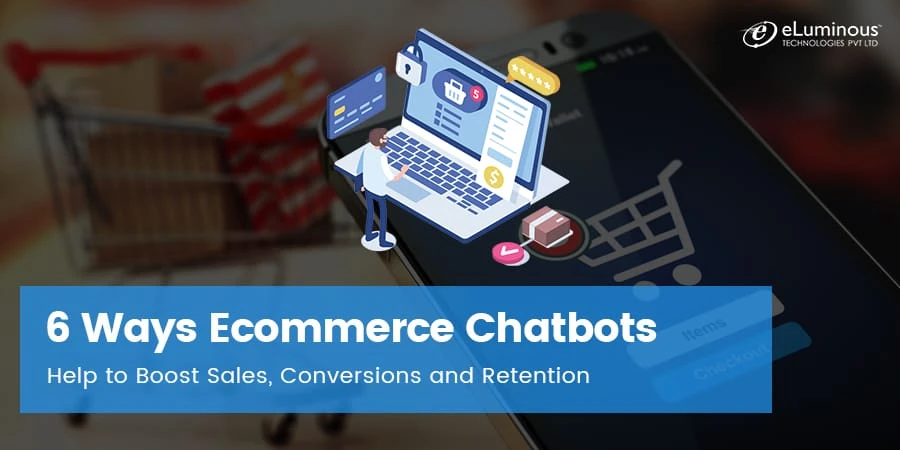
6 Ways Ecommerce Chatbots Help to Increase Sales, Conversions & Retention
The eCommerce market is growing, and at breakneck speed. By 2021, worldwide online retail sales are projected at $4.9 trillion. That’s close to a quarter of the estimated American GDP for 2019.
However, competing for a slice of that giant pie are more 20 million eCommerce websites around the world. What’s worse is that hardly half of them are generating any meaningful revenue at all.
What this means for you as an eCommerce seller is that simply being online won’t cut it anymore. Competition is fierce, which means you have to do everything you can to stay ahead of the curve and match a step with the latest eCommerce trends.
And it’s once such trend, Chatbots, which is the focus of this post. Gartner predicts 85% customer service interactions will be handled by chatbots come 2020.
And contrary to popular perception, a significant section of consumers is open to using chatbots for their purchase.
That it’s a 2017 report is only more encouraging as chatbots have become more human-like in the intervening two years thanks to better NLP (natural language processing) and machine learning algorithms.
These advancements have also meant that chatbots aren’t used for only basic customer chat functions anymore. Sellers on major eCommerce platforms can simply hire a Shopify developer or WooCommerce expert to implement chatbot integration for various customer service tasks.
But what sort of tasks are these? Can eCommerce bots fully replace human-human interaction? More importantly, how chatbots can help increase sales, convert more visitors into buyers, and hold on to existing customers?
Read on for answers.
Easy Ordering
With every third smartphone user in the world using messaging apps, it was natural for eCommerce players to tap these social media apps for more sales. What also works in their favor is that it’s more convenient for a user to place an order within the messaging app, rather than switching to another one.
Popular pizza-maker Domino’s enables customers to easily place an order through three different platforms, viz. Google Assistant, Facebook Messenger, and Amazon Alexa.

Domino’s Facebook Messenger Domino’s Amazon Alexa
These chatbots enable Domino’s customers to place an order from within their preferred messaging app or virtual assistant. Apart from helping save your customers’ time, such a chatbot ordering option also makes your eCommerce store more accessible.
Preventing Shopping Cart Abandonment
In a previous post on this blog, we talked about how shopping cart abandonment is the bane of the eCommerce industry. A staggering 70% of eCommerce users abandon their cart before completing a purchase. As an eCommerce seller, every abandoned cart represents a lost opportunity to make a sale.
Let’s understand this through a simple back of the envelope example. Let’s say you get 50,000 visitors a month to your online store. Let’s also assume your average transaction is $30 and you enjoy a conversion rate of 1%, i.e. 500 customers.
Now if you could boost this conversion rate by even 0.25%, you’re looking at an extra $3,750 per month – or $45,000 per year.
What’s even better is that you can achieve this increase in the conversion rate by implementing a shopping cart abandonment chatbot on your eCommerce store.
As per a study, the recovery rate is between 13% and 20% when abandoned cart reminders are sent through Messenger. Moreover, these reminders also generated between 4x and 10x more revenue than similar reminders sent through email.
These figures are proof that sending cart abandonment messages through chatbots can
- Get more people to open/view them compared to email messages – higher open rates.
- Get more people to click through compared to email messages – higher CTR.
- Get delivered as there’s no risk of being labeled spam or promotions like with emails – more visibility.
- Give users an easier and more intimate way of communicating with you – eCommerce personalization.
Footwear and accessories seller Cole Haan has made the most of these advantages by implementing a Facebook Messenger chatbot to streamline its customer service process. It pitches in with product recommendations, discount coupons, and even sends a cart abandonment reminder, among other things.

Recommending Products
While the choice is good, too much of it can backfire and lead to the dreaded shopping cart abandonment. A great way to avoid this is by matching the right product with your customer’s needs.
Sephora has perfected this tactic to the T ever since it launched its Kik (a popular messaging app with a large teenage user base) chatbot. The Sephora Kik chatbot is the next best thing to having a real person dish out makeup advice. When a Kik user opens it, the chatbot asks them to provide some essential details through a quiz that lasts a few seconds.

Once the quiz is completed, the user is able to browse products, receive personalized beauty tips, and much more. And much like a real-life salesperson, the Sephora Kik bot even asks its users targeted questions on their tastes to provide better product recommendations.
And once a user has settled upon a product, they can simply pay for it from within the Kik messenger app itself.
By implementing a chatbot solution along these lines, you can not only help your customers find what they want quickly but also suggest products that meet their individual needs and preferences.
Transactional Messaging
Transactional messages are those that convey specific information about a transaction to a buyer. Examples of such information include welcome greeting, order confirmation, shipping update, shipment out for delivery, shipment delivered, product messages, collections, and options intros, etc.
Email marketing has shown that transactional messages have much higher open rates and CTRs than promotional messages. When you combine that with the increasing customer willingness to receive such messages through messenger app chatbots, it’s a no-brainer to invest in such a chatbot for your eCommerce store.

For instance, you can hire a Shopify developer to use Shopify Facebook Messenger integration for automating a set of custom messages that your customers will receive at important steps during the buying process.
Sending customized messages offers a great opportunity to take the conversation with your customers beyond routine transactional messages and give a personal touch to the interaction.
Upselling & Cross-Selling
5-25 times – that’s how much more you’ll end up spending to acquire a new customer than holding on to an existing one. Also, consider the fact that a retailer like Amazon earns up to 35% of its profits by upselling and cross-selling.
While these stats acknowledge the importance of upselling and cross-selling for eCommerce success, what often goes unnoticed is that chatbots can do a stellar job of them. And thanks to the personalized nature of chatbots, it’s a given that customers too would be open to such implementations.
And few have done it better than Levis’ Ask Indigo chatbot, which offers personalized product recommendations by combining previously obtained customer preference data (through quizzes for instance) with data on customer actions.

Because of such customer interactions, chatbots are better place to upsell, cross-sell, and recommend better and higher-margin products to your visitors. This makes them a great way to boost your eCommerce store’s revenue without spending to acquire new customers.
Chatbot Product Guides for Easier Shopping
There was a time when consumers knew exactly what they wanted when they shopped online. But thanks to an explosion of choices, that’s no longer the case. In fact, a massive 83% online buyers need help with completing an order.
And when you consider that over 70% online buyers expect some buying assistance within the first 5 minutes, it becomes clear that not only do you have to offer help but also be prompt with it. If you don’t, losing a customer becomes a certainty.
This is where chatbots can prove to be of great help. A chatbot can act as a virtual guide of your eCommerce store and gives you an opportunity to open up a conversation with a visitor when they need assistance.
As illustrated below, a chatbot product guide can be handy when sizing is important to make the sale. Another hypothetical example would be a chatbot asking for a room’s type and dimensions before recommending suitable lighting solutions.

With a chatbot, you can be more proactive in your customer service. It can enable you to explain your product range, individual product features and benefits, answer questions and concerns, and provide any other insight that a buyer might find useful. In addition to driving more sales, this approach builds greater customer loyalty.
Over to You
These are just some of the more popular ways eCommerce chatbots help to increase sales, conversions, and retention. If you’re selling online through a particular platform like Shopify or Magento, you can simply hire a Shopify developer or Magento eCommerce expert to help you with integrating chatbots with your online store’s functions.
That said, modern chatbots can help you increase sales even for your offline store. For instance, they can help you make the most of an omnichannel strategy by leveraging Messenger scan codes (Facebook and Snapchat), promoting location-specific offers, and offering live chat within a physical store to help with a purchase.
With greater advancements being made in NLP and machine learning, the day is not far when chatbots extend their reach to every aspect of eCommerce shopping and some bits of offline shopping as well.



